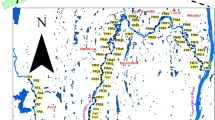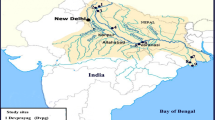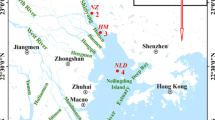Abstract
Recent efforts have been made to determine the environmental impact of mining over the past 11 years in the Jequetepeque River basin, in northern Peru. We have now analyzed data from two studies to elucidate the spatial and temporal trace metal distributions and to assess the sources of contamination. These two studies were carried out from 2003 to 2008 by a Peruvian government administration and from 2008 to 2010 by us. We analyzed 249 samples by principal component analysis, measuring: pH, electrical conductivity, total dissolved solids, total suspended solids, chloride, weak-acid-dissociable cyanide, total cyanide, nitrite and nitrate, ammonium, sulfate, and trace metals and metalloids (Al, As, Ca, Cd, Cu, Cr, Fe, Mg, Mn, Ni, Pb, and Zn). Within the spatial distribution of the basin, the highest Al, As, Cu, Fe, Ni, and Pb concentrations were found at the closest point to the mine sites for both periods of time, with the higher peaks measured during the first years of the sampling data. Temporal trends showed higher concentrations of Cu and Fe in samples taken before 2005, at which point the two mines were closed. Risk assessment was quantified by the hazard quotient as related to water ingestion. The risk for human health posed by the concentrations of several trace metals and metalloids was found to be highly adverse (As and Cr), significant (Al, Cd, Cu, Fe, and Pb), or minimal (Ni and Zn).





Similar content being viewed by others
References
ASTM 2000. Standard guide for collection, storage, characterization, and manipulation of sediments for toxicological testing. p. 768–788. En: 2000 ASTM Standards on Environmental Sampling, vol.11.05.
Bebbington A, C.M., Coxshal W, O’Shaughnessy H, Williams M. (2007). Mining and development in Peru. Peru Support Group. Accessed on 7 June 2011. http://www.perusupportgroup.org.uk.
Bengraine, K., & Marhaba, T. F. (2003). Using principal component analysis to monitor spatial and temporal changes in water quality. Journal of Hazardous Materials, 100, 179–195.
Cánovas, C. R., Hubbard, C. G., Olias, M., Nieto, J. M., Black, S., & Coleman, M. L. (2008). Hydrochemical variations and contaminant load in the Rio Tinto (Spain) during flood events. Journal of Hydrology, 350, 25–40.
CARE, W.W.F.f.N., Gesellschaft für Technische Zusammenarbeit, International Institut for Environment and Development, Centro Ecumenico de Acción y Promoción Social. Proyecto Compensación Equitativa por Servicios Ambientales Hidrológicos (CESAH). Cajamarca, 2007.
Chen, C. M., & Liu, M. C. (2006). Ecological risk assessment on a cadmium contaminated soil landfill—A preliminary evaluation based on toxicity tests on local species and site-specific information. Science of the Total Environment, 359, 120–129.
De Miguel, E., Iribarren, I., Chacon, E., Ordonez, A., & Charlesworth, S. (2007). Risk-based evaluation of the exposure of children to trace elements in playgrounds in Madrid (Spain). Chemosphere, 66, 505–513.
Government, P. (2009a). Peruvian law of the environment. LEY N° 28611. Access on December 2011. http://www.redrrss.pe/material/20090128191512.pdf.
Government, P. (2009b). Peruvian law of water resources. LEY N° 29338. Access on December 2011. http://www.ana.gob.pe/media/316755/leyrh.pdf.
Gozzard, E., Mayes, W. M., Potter, H. A. B., & Jarvis, A. P. (2011). Seasonal and spatial variation of diffuse (non-point) source zinc pollution in a historically metal mined river catchment, UK. Environmental Pollution, 159, 3113–3122.
Han, Y. M., Du, P. X., Cao, J. J., & Posmentier, E. S. (2006). Multivariate analysis of heavy metal contamination in urban dusts of Xi'an, Central China. Science of the Total Environment, 355, 176–186.
Instituto Nacional de Recursos Naturales del Ministerio de Agricultura, INRENA. (2005). Proyecto Especial Jequetepeque-Zaña (PEJEZA). Plan de ordenamiento, manejo ambiental y Desarrollo Social en la Cuenca media y Alta del Río Jequetepeque para la protección del embalse Gallito Ciego. Cajamarca, Perú; 2005.
Joshi, U. M., & Balasubramanian, R. (2010). Characteristics and environmental mobility of trace elements in urban runoff. Chemosphere, 80, 310–318.
Kartal, S., Aydin, Z., & Tokalioglu, S. (2006). Fractionation of metals in street sediment samples by using the BCR sequential extraction procedure and multivariate statistical elucidation of the data. Journal of Hazardous Materials, 132, 80–89.
Li, S. Y., & Zhang, Q. F. (2010a). Risk assessment and seasonal variations of dissolved trace elements and heavy metals in the Upper Han River, China. Journal of Hazardous Materials, 181, 1051–1058.
Li, S. Y., & Zhang, Q. F. (2010b). Spatial characterization of dissolved trace elements and heavy metals in the upper Han River (China) using multivariate statistical techniques. Journal of Hazardous Materials, 176, 579–588.
Lin, C., Wu, Y., Lu, W., Chen, A., & Liu, Y. (2007). Water chemistry and ecotoxicity of an acid mine drainage-affected stream in subtropical China during a major flood event. Journal of Hazardous Materials, 142, 199–207.
Luis, A. T., Teixeira, P., Almeida, S. F. P., Matos, J. X., & da Silva, E. F. (2010). Environmental impact of mining activities in the Lousal area (Portugal) Chemical and diatom characterization of metal-contaminated stream sediments and surface water of Corona stream. Science of the Total Environment, 409, 4312–4325.
Ma, Y., Lu, W., & Lin, C. (2011). Downstream patterns of bed sediment-borne metals, minerals and organic matter in a stream system receiving acidic mine effluent: A preliminary study. Journal of Geochemical Exploration, 110, 98–106.
Macklin, M. G., Brewer, P. A., Hudson-Edwards, K. A., Bird, G., Coulthard, T. J., Dennis, I. A., et al. (2006). A geomorphological approach to the management of rivers contaminated by metal mining. Geomorphology, 79, 423–447.
Marcus, M. D., Covington, S., Liu, B. L., & Smith, N. R. (2010). Use of existing water, sediment, and tissue data to screen ecological risks to the endangered Rio Grande silvery minnow. Science of the Total Environment, 409, 83–94.
Miller JR, L.P., Hudson-Edwards KA, Macklin MG (2002). Lead isotopic fingerprinting of heavy metal contamination, Río Pilcomayo basin, Bolivia. Geochemistry Exploration, Environment, Analysis 9, 115–123. Miller JR, Lechler PJ, Hudson-Edwards KA, Macklin MG.
Miller, J. R., Hudson-Edwards, K. A., Lechler, P. J., Preston, D., & Macklin, M. G. (2004). Heavy metal contamination of water, soil and produce within riverine communities of the Río Pilcomayo basin, Bolivia. Science of the Total Environment, 320, 189–209.
Ministerio de Salud (2008). Cajamarca saludable II. Gobierno Regional de Cajamarca (ed.), Ministerio de Salud, Dirección General de Salud Ambiental, DIGESA, Cajamarca.
MWH Global Inc. (2006). Environmental impact assessment “Proyecto suplementario Yanacocha Oeste”.
Parra, A., Oyarzun, J., Maturana, H., Kretschmer, N., Meza, F., & Oyarzun, R. (2011). Natural factors and mining activity bearings on the water quality of the Choapa basin, North Central Chile insights on the role of mafic volcanic rocks in the buffering of the acid drainage process. Environmental Monitoring and Assessment, 181, 69–82.
Passos, E. D., Alves, J. C., dos Santos, I. S., Alves, J. D. H., Garcia, C. A. B., & Costa, A. C. S. (2010). Assessment of trace metals contamination in estuarine sediments using a sequential extraction technique and principal component analysis. Microchemical Journal, 96, 50–57.
Palmer, S. C. J., van Hinsberg, V. J., McKenzie, J. M., & Yee, S. (2011). Characterization of acid river dilution and associated trace element behavior through hydrogeochemical modeling: A case study of the Banyu Pahit River in East Java, Indonesia. Applied Geochemistry, 26, 1802–1810.
Perez, G., & Valiente, M. (2005). Determination of pollution trends in an abandoned mining site by application of a multivariate statistical analysis to heavy metals fractionation using SM&T-SES. Journal of Environmental Monitoring, 7, 29–36.
Romero, A., Gonzalez, I., & Galan, E. (2006). Estimation of potential pollution of waste mining dumps at Pena del Hierro (Pyrite Belt, SW Spain) as a base for future mitigation actions. Applied Geochemistry, 21, 1093–1108.
S.A.C., I. (2010). Mine closure plan for Yanacocha facilities. Executive summary, August 2010.
Sarmiento, A. M., DelValls, A., Miguel Nieto, J., Jose Salamanca, M., & Caraballo, M. A. (2011). Toxicity and potential risk assessment of a river polluted by acid mine drainage in the Iberian Pyrite Belt (SW Spain). Science of the Total Environment, 409, 4763–4771.
Shrestha, S., & Kazama, F. (2007). Assessment of surface water quality using multivariate statistical techniques: A case study of the Fuji river basin, Japan. Environmental Modelling and Software, 22, 464–475.
Tarras-Wahlberg, N. H., & Nguyen, L. T. (2008). Environmental regulatory failure and metal contamination at the Giap Lai pyrite mine, Northern Vietnam. Journal of Environmental Management, 86, 712–720.
USEPA (US Environmental Protection Agency). (1987). Quality assurance/quality control (QA/QC) for 301(h) monitoring programs: Guidance on field and laboratory methods. EPA 430/9-86-004.
USEPA (US Environmental Protection Agency). (1989). Risk assessment guidance for superfund. Human health evaluation manual. EPA/540/1-89/002, vol. I. Office of Solid Waste and Emergency Response. Washington D.C.
USEPA (US Environmental Protection Agency). (2010). IRIS (Integrated Risk Information System). Reference dose for oral exposure. Accessed at: http://www.epa.gov/iris.
Yacoub, C., Pérez-Foguet, A., & Miralles, N. (2011). Risk assessment and seasonal variations in southern countries: Trace metal emissions in the Upper Basin Jequetepeque. IWA Watermatex, San Sebastian, Spain: Peru.
Yacoub, C., Pérez-Foguet, A. & Miralles, N. (2012). Trace metal content of sediments close to mine sites in the Andean region. The Scientific World Journal 2012, 12pages, doi:10.1100/2012/732519.
Acknowledgments
This research was supported by the UPC’s Center for Development Cooperation, CCD. Thanks are due to the Cajamarca Regional Government for support in the data collection and the monitoring process, and to the Pontificia Universidad Católica del Perú.
Author information
Authors and Affiliations
Corresponding author
Rights and permissions
About this article
Cite this article
Yacoub, C., Blazquez, N., Pérez-Foguet, A. et al. Spatial and temporal trace metal distribution of a Peruvian basin: recognizing trace metal sources and assessing the potential risk. Environ Monit Assess 185, 7961–7978 (2013). https://doi.org/10.1007/s10661-013-3147-x
Received:
Accepted:
Published:
Issue Date:
DOI: https://doi.org/10.1007/s10661-013-3147-x




